The Cambridge History of Japan, Vol. 3: Medieval Japan
Подождите немного. Документ загружается.

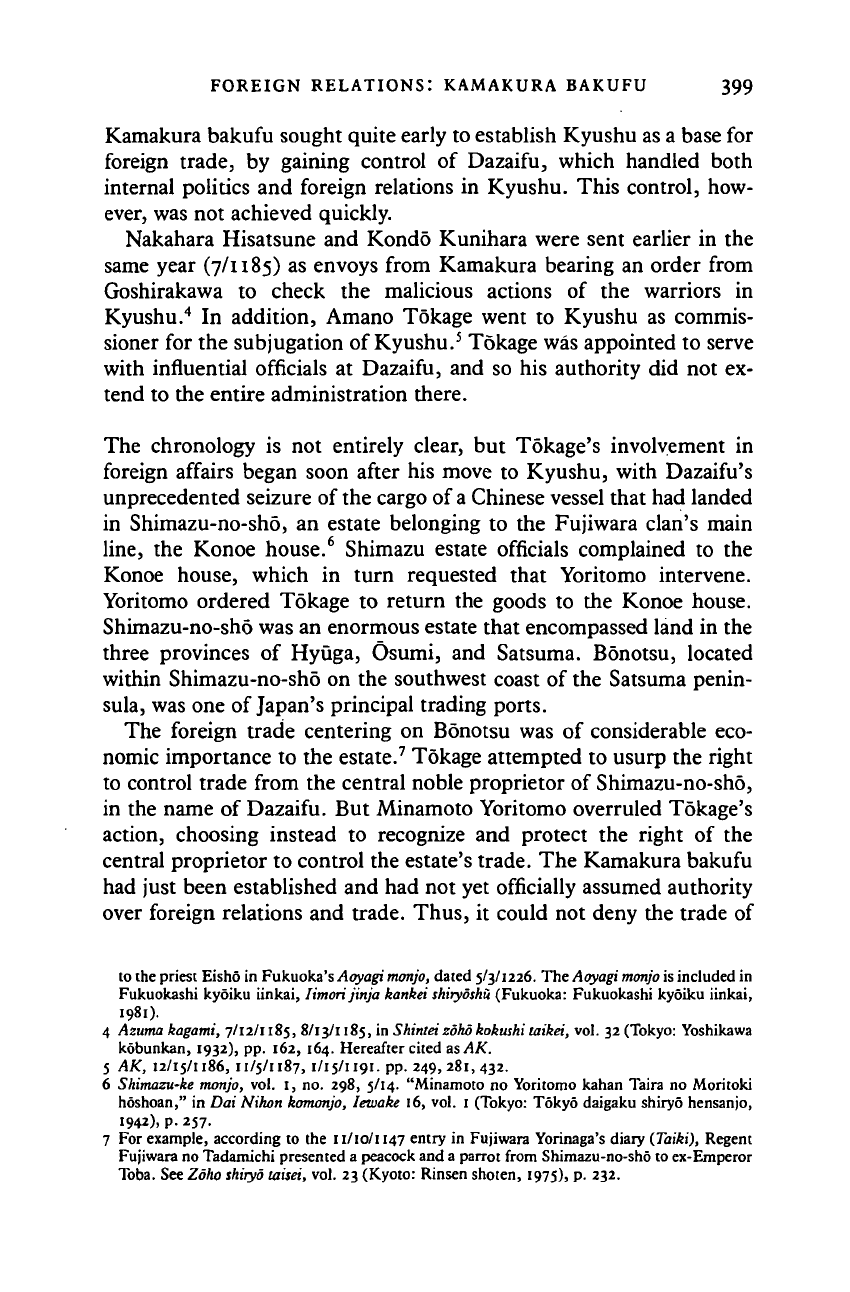
FOREIGN RELATIONS: KAMAKURA BAKUFU 399
Kamakura bakufu sought quite early to establish Kyushu as a base for
foreign trade, by gaining control of Dazaifu, which handled both
internal politics and foreign relations in Kyushu. This control, how-
ever, was not achieved quickly.
Nakahara Hisatsune and Kondo Kunihara were sent earlier in the
same year (7/1185) as envoys from Kamakura bearing an order from
Goshirakawa to check the malicious actions of the warriors in
Kyushu.
4
In addition, Amano Tokage went to Kyushu as commis-
sioner for the subjugation of Kyushu.
5
Tokage was appointed to serve
with influential officials at Dazaifu, and so his authority did not ex-
tend to the entire administration there.
The chronology is not entirely clear, but Tokage's involvement in
foreign affairs began soon after his move to Kyushu, with Dazaifu's
unprecedented seizure of the cargo of
a
Chinese vessel that had landed
in Shimazu-no-sho, an estate belonging to the Fujiwara clan's main
line,
the Konoe house.
6
Shimazu estate officials complained to the
Konoe house, which in turn requested that Yoritomo intervene.
Yoritomo ordered Tokage to return the goods to the Konoe house.
Shimazu-no-sho was an enormous estate that encompassed land in the
three provinces of Hyuga, Osumi, and Satsuma. Bdnotsu, located
within Shimazu-no-sho on the southwest coast of the Satsuma penin-
sula, was one of Japan's principal trading ports.
The foreign trade centering on Bonotsu was of considerable eco-
nomic importance to the estate.
7
Tokage attempted to usurp the right
to control trade from the central noble proprietor of Shimazu-no-sho,
in the name of Dazaifu. But Minamoto Yoritomo overruled Tokage's
action, choosing instead to recognize and protect the right of the
central proprietor to control the estate's trade. The Kamakura bakufu
had just been established and had not yet officially assumed authority
over foreign relations and trade. Thus, it could not deny the trade of
to the priest Eisho in Fukuoka's Aoyagi
monjo,
dated 5/3/1226. The Aoyagi
monjo
is included in
Fukuokashi kyoiku iinkai, Iimorijinja kankei
shiryoshu
(Fukuoka: Fukuokashi kyoiku iinkai,
1981).
4 Azutna kagami, 7/12/1185, 8/13/1185, in Shinleizoho
kokushi
laikei, vol. 32 (Tokyo: Yoshikawa
kobunkan, 1932), pp. 162, 164. Hereafter cited
as.i4Af.
5 AK, 12/15/1186, 11/5/1187, 1/15/1191. pp. 249,281,432.
6 Shimazu-ke monjo, vol. I, no. 298, 5/14. "Minamoto no Yoritomo kahan Taira no Moritoki
hoshoan," in Dai Nihon
komonjo,
lewake 16, vol. 1 (Tokyo: Tokyo daigaku shiryo hensanjo,
1942),
p. 257.
7 For example, according to the 11/10/1147 entry in Fujiwara Yorinaga's diary (Taiki), Regent
Fujiwara no Tadamichi presented a peacock and a parrot from Shimazu-no-sho to ex-Emperor
Toba. See Zoho
shiryo
taisei, vol. 23 (Kyoto: Rinsen shoten, 1975), p. 232.
Cambridge Histories Online © Cambridge University Press, 2008
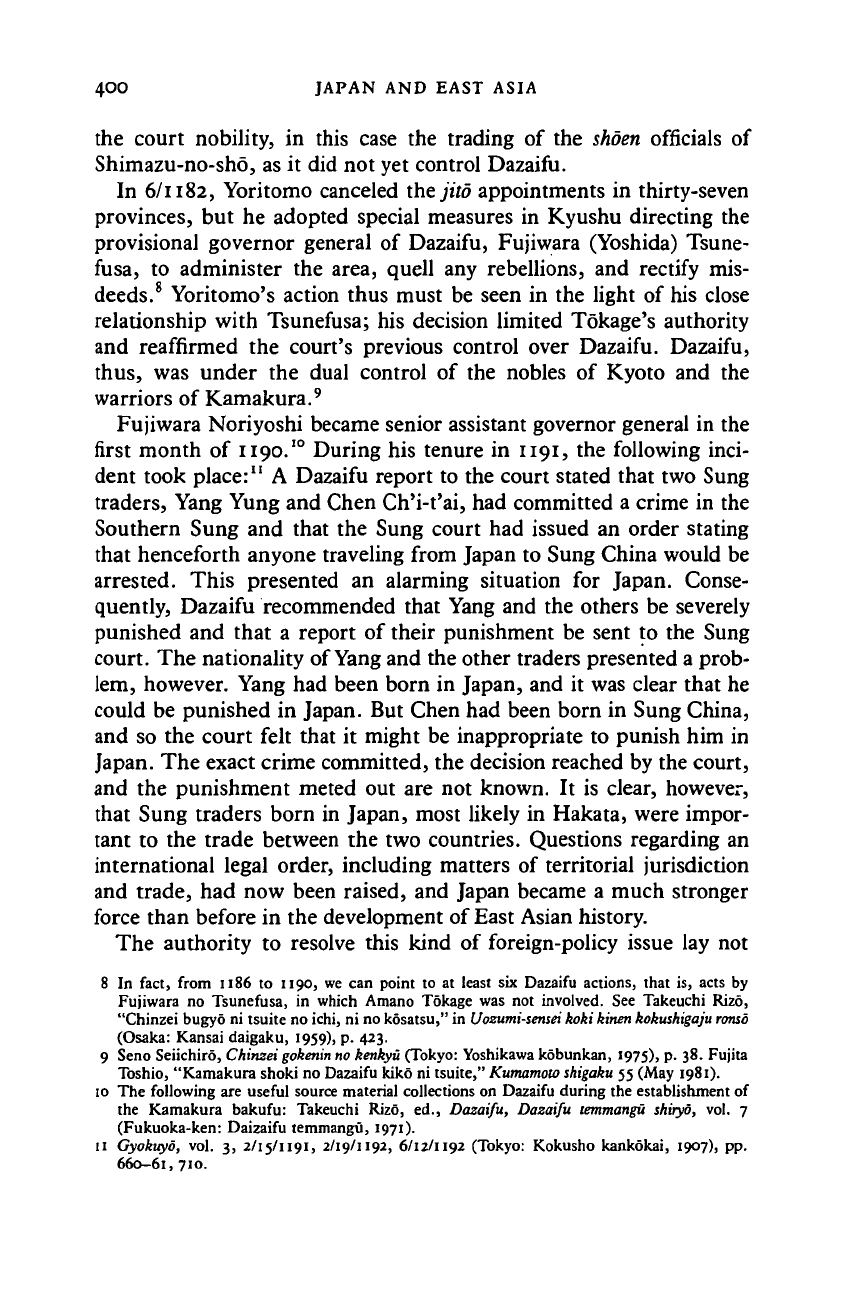
4OO JAPAN AND EAST ASIA
the court nobility, in this case the trading of the
shoen
officials of
Shimazu-no-sho, as it did not yet control Dazaifu.
In 6/1182, Yoritomo canceled the
jito
appointments in thirty-seven
provinces, but he adopted special measures in Kyushu directing the
provisional governor general of Dazaifu, Fujiwara (Yoshida) Tsune-
fusa, to administer the area, quell any rebellions, and rectify mis-
deeds.
8
Yoritomo's action thus must be seen in the light of his close
relationship with Tsunefusa; his decision limited Tokage's authority
and reaffirmed the court's previous control over Dazaifu. Dazaifu,
thus,
was under the dual control of the nobles of Kyoto and the
warriors of Kamakura.
9
Fujiwara Noriyoshi became senior assistant governor general in the
first month of 1190.
10
During his tenure in 1191, the following inci-
dent took place:
11
A Dazaifu report to the court stated that two Sung
traders, Yang Yung and Chen Ch'i-t'ai, had committed a crime in the
Southern Sung and that the Sung court had issued an order stating
that henceforth anyone traveling from Japan to Sung China would be
arrested. This presented an alarming situation for Japan. Conse-
quently, Dazaifu recommended that Yang and the others be severely
punished and that a report of their punishment be sent to the Sung
court. The nationality of
Yang
and the other traders presented a prob-
lem, however. Yang had been born in Japan, and it was clear that he
could be punished in Japan. But Chen had been born in Sung China,
and so the court felt that it might be inappropriate to punish him in
Japan. The exact crime committed, the decision reached by the court,
and the punishment meted out are not known. It is clear, however,
that Sung traders born in Japan, most likely in Hakata, were impor-
tant to the trade between the two countries. Questions regarding an
international legal order, including matters of territorial jurisdiction
and trade, had now been raised, and Japan became a much stronger
force than before in the development of East Asian history.
The authority to resolve this kind of foreign-policy issue lay not
8 In fact, from 1186 to 1190, we can point to at least six Dazaifu actions, that is, acts by
Fujiwara no Tsunefusa, in which Amano Tokage was not involved. See Takeuchi Rizo,
"Chinzei bugyo ni tsuite no ichi, ni no kosatsu," in
Uozumi-sensei
koki
kinen kokushxgaju ronso
(Osaka: Kansai daigaku, 1959), p. 423.
9 Seno Seiichiro, Chinzei
gokenin
no
kenkyu
(Tokyo: Yoshikawa kobunkan, 1975), p. 38. Fujita
Toshio, "Kamakura shoki no Dazaifu kiko ni tsuite,"
Kumamoto shigaku
55 (May 1981).
10 The following are useful source material collections on Dazaifu during the establishment of
the Kamakura bakufu: Takeuchi Rizo, ed., Dazaifu, Dazaifu temmangu shiryo, vol. 7
(Fukuoka-ken: Daizaifu temmangu, 1971).
11 Gyokuyo, vol. 3, 2/15/1191, 2/19/1192, 6/12/1192 (Tokyo: Kokusho kankokai, 1907), pp.
660-61,
710.
Cambridge Histories Online © Cambridge University Press, 2008
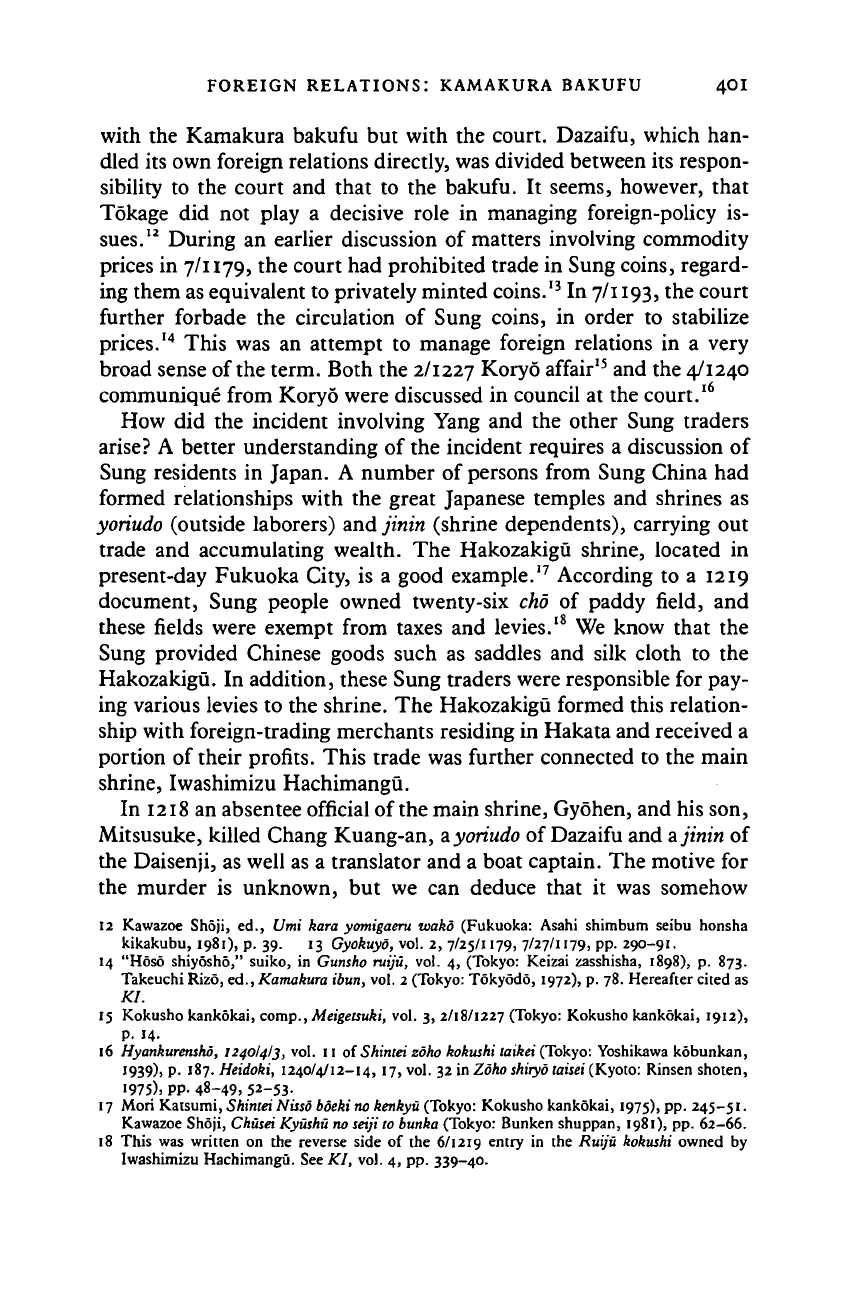
FOREIGN RELATIONS: KAMAKURA BAKUFU 401
with the Kamakura bakufu but with the court. Dazaifu, which han-
dled its own foreign relations directly, was divided between its respon-
sibility to the court and that to the bakufu. It seems, however, that
Tokage did not play a decisive role in managing foreign-policy is-
sues.
12
During an earlier discussion of matters involving commodity
prices in 7/1179, the court had prohibited trade in Sung coins, regard-
ing them as equivalent to privately minted coins.
13
In 7/1193, the court
further forbade the circulation of Sung coins, in order to stabilize
prices.
14
This was an attempt to manage foreign relations in a very
broad sense of the term. Both the 2/1227 Koryo affair
15
and the 4/1240
communique from Koryo were discussed in council at the court.
16
How did the incident involving Yang and the other Sung traders
arise? A better understanding of the incident requires a discussion of
Sung residents in Japan. A number of persons from Sung China had
formed relationships with the great Japanese temples and shrines as
yoriudo (outside laborers) and jinin (shrine dependents), carrying out
trade and accumulating wealth. The Hakozakigu shrine, located in
present-day Fukuoka City, is a good example.
17
According to a 1219
document, Sung people owned twenty-six cho of paddy field, and
these fields were exempt from taxes and levies.'
8
We know that the
Sung provided Chinese goods such as saddles and silk cloth to the
Hakozakigu. In addition, these Sung traders were responsible for pay-
ing various levies to the shrine. The Hakozakigu formed this relation-
ship with foreign-trading merchants residing in Hakata and received a
portion of their profits. This trade was further connected to the main
shrine, Iwashimizu Hachimangu.
In 1218 an absentee official of the main shrine, Gyohen, and his son,
Mitsusuke, killed Chang Kuang-an, a. yoriudo of Dazaifu and a jinin of
the Daisenji, as well as a translator and a boat captain. The motive for
the murder is unknown, but we can deduce that it was somehow
12 Kawazoe Shoji, ed., Umi kara yomigaeru wako (Fukuoka: Asahi shimbum seibu honsha
kikakubu, 1981), p. 39. 13 Gyokuyo, vol. 2, 7/25/1179, 7/27/1179, pp.
290-91.
14 "Hoso shiyosho," suiko, in Gunsho ruiju, vol. 4, (Tokyo: Keizai zasshisha, 1898), p. 873.
Takeuchi Rizo, ed., Kamakura ibun, vol. 2 (Tokyo: Tokyodo, 1972), p. 78. Hereafter cited as
KI.
15 Kokusho kankokai, comp., Meigetsuki, vol. 3, 2/18/1227 (Tokyo: Kokusho kankokai, 1912),
p.
14.
16 Hyankurensho, 1240I4I3, vol. 11 of Shituei zoho kokushi taikei (Tokyo: Yoshikawa kobunkan,
'939)> P- 187. Heidoki, 1240/4/12-14, 17, vol. 32 in Zoho
shiryo taisei
(Kyoto: Rinsen shoten,
1975).
PP- 48-49.
52-53-
17 Mori Katsumi, Shiniei Nisso boeki no kenkyu (Tokyo: Kokusho kankokai, 1975), pp.
245-51.
Kawazoe Shoji, Chusei Kyushu no seiji to bunka (Tokyo: Bunken shuppan, 1981), pp. 62-66.
18 This was written on the reverse side of the 6/1219 entry in the Ruiju kokushi owned by
Iwashimizu Hachimangu.
SeeKI,
vol. 4, pp. 339-40.
Cambridge Histories Online © Cambridge University Press, 2008
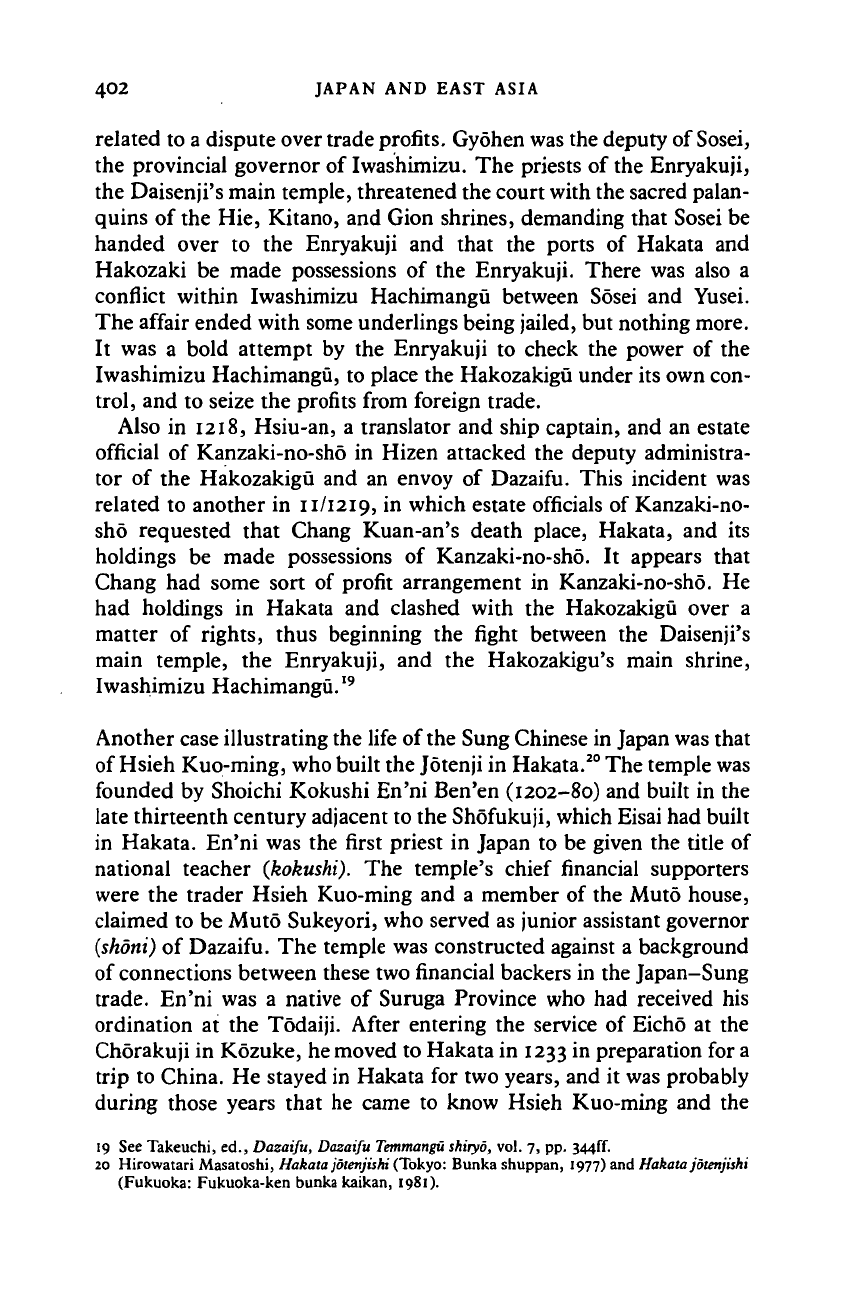
402 JAPAN AND EAST ASIA
related to a dispute over trade profits. Gyohen was the deputy of Sosei,
the provincial governor of Iwashimizu. The priests of the Enryakuji,
the Daisenji's main temple, threatened the court with the sacred palan-
quins of the Hie, Kitano, and Gion shrines, demanding that Sosei be
handed over to the Enryakuji and that the ports of Hakata and
Hakozaki be made possessions of the Enryakuji. There was also a
conflict within Iwashimizu Hachimangu between Sosei and Yusei.
The affair ended with some underlings being jailed, but nothing more.
It was a bold attempt by the Enryakuji to check the power of the
Iwashimizu Hachimangu, to place the Hakozakigu under its own con-
trol, and to seize the profits from foreign trade.
Also in 1218, Hsiu-an, a translator and ship captain, and an estate
official of Kanzaki-no-sho in Hizen attacked the deputy administra-
tor of the Hakozakigu and an envoy of Dazaifu. This incident was
related to another in n/1219, in which estate officials of Kanzaki-no-
sho requested that Chang Kuan-an's death place, Hakata, and its
holdings be made possessions of Kanzaki-no-sho. It appears that
Chang had some sort of profit arrangement in Kanzaki-no-sho. He
had holdings in Hakata and clashed with the Hakozakigu over a
matter of rights, thus beginning the fight between the Daisenji's
main temple, the Enryakuji, and the Hakozakigu's main shrine,
Iwashimizu Hachimangu.
19
Another case illustrating the life of
the
Sung Chinese in Japan was that
of Hsieh Kuo-ming, who built the Jotenji in Hakata.
20
The temple was
founded by Shoichi Kokushi En'ni Ben'en (1202-80) and built in the
late thirteenth century adjacent to the Shofukuji, which Eisai had built
in Hakata. En'ni was the first priest in Japan to be given the title of
national teacher (kokushi). The temple's chief financial supporters
were the trader Hsieh Kuo-ming and a member of the Muto house,
claimed to be Muto Sukeyori, who served as junior assistant governor
(shdni)
of Dazaifu. The temple was constructed against a background
of connections between these two
financial
backers in the Japan-Sung
trade. En'ni was a native of Suruga Province who had received his
ordination at the Todaiji. After entering the service of Eicho at the
Chorakuji in Kozuke, he moved to Hakata in
1233
in preparation for a
trip to China. He stayed in Hakata for two years, and it was probably
during those years that he came to know Hsieh Kuo-ming and the
19 See Takeuchi, ed., Dazaifu, Dazaifu
Temmangu
shiryo, vol. 7, pp.
344ff.
20 Hirowatari Masatoshi, Hakaia
joienjishi
(Tokyo: Bunka shuppan, 1977) and Hakata jotenjishi
(Fukuoka: Fukuoka-ken bunka kaikan, 1981).
Cambridge Histories Online © Cambridge University Press, 2008
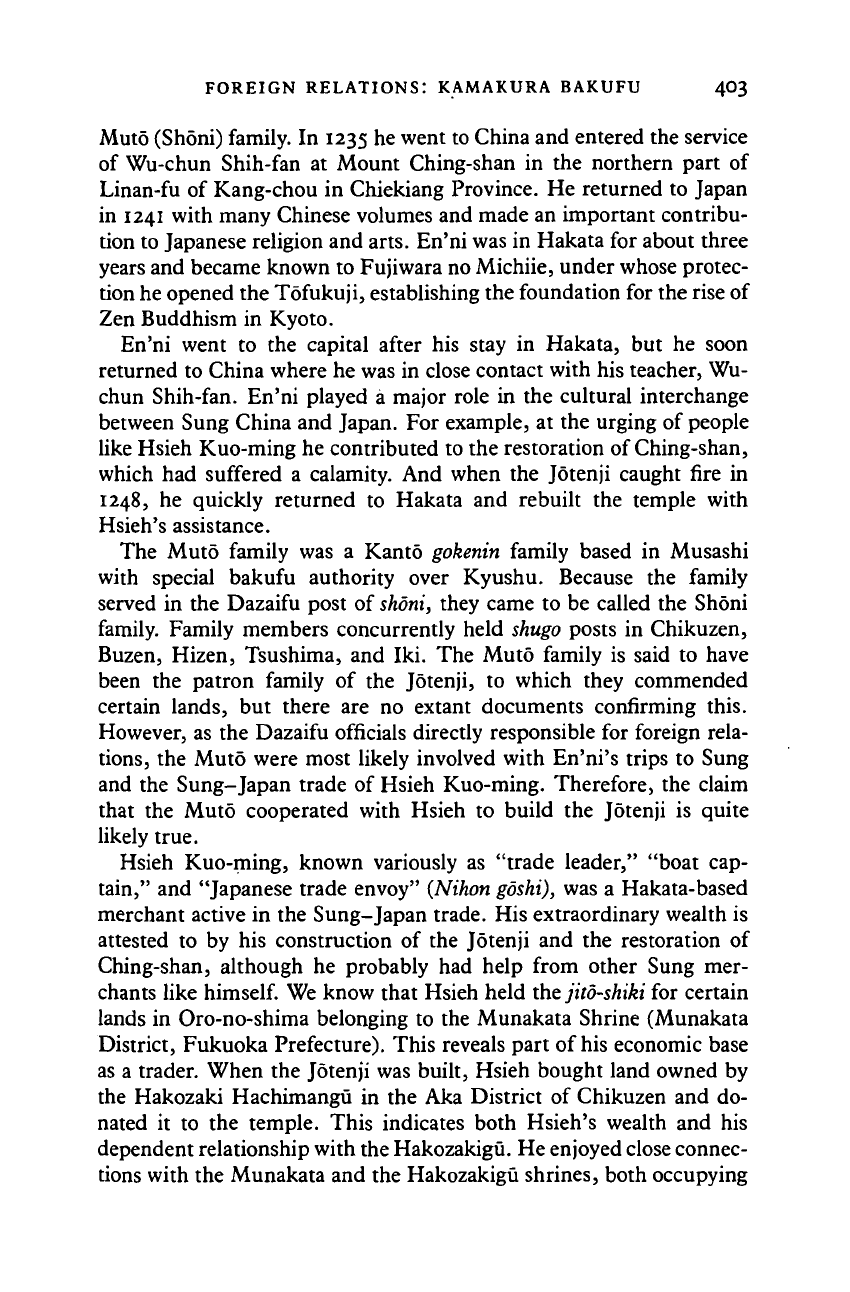
FOREIGN RELATIONS: KAMAKURA BAKUFU 403
Muto (Shoni) family. In 1235 he went to China and entered the service
of Wu-chun Shih-fan at Mount Ching-shan in the northern part of
Linan-fu of Kang-chou in Chiekiang Province. He returned to Japan
in 1241 with many Chinese volumes and made an important contribu-
tion to Japanese religion and arts. En'ni was in Hakata for about three
years and became known to Fujiwara no Michiie, under whose protec-
tion he opened the Tofukuji, establishing the foundation for the rise of
Zen Buddhism in Kyoto.
En'ni went to the capital after his stay in Hakata, but he soon
returned to China where he was in close contact with his teacher, Wu-
chun Shih-fan. En'ni played a major role in the cultural interchange
between Sung China and Japan. For example, at the urging of people
like Hsieh Kuo-ming he contributed to the restoration of Ching-shan,
which had suffered a calamity. And when the Jotenji caught fire in
1248,
he quickly returned to Hakata and rebuilt the temple with
Hsieh's assistance.
The Muto family was a Kanto
gokenin
family based in Musashi
with special bakufu authority over Kyushu. Because the family
served in the Dazaifu post of
shoni,
they came to be called the Shoni
family. Family members concurrently held
shugo
posts in Chikuzen,
Buzen, Hizen, Tsushima, and Iki. The Muto family is said to have
been the patron family of the Jotenji, to which they commended
certain lands, but there are no extant documents confirming this.
However, as the Dazaifu officials directly responsible for foreign rela-
tions,
the Muto were most likely involved with En'ni's trips to Sung
and the Sung-Japan trade of Hsieh Kuo-ming. Therefore, the claim
that the Muto cooperated with Hsieh to build the Jotenji is quite
likely true.
Hsieh Kuo-ming, known variously as "trade leader," "boat cap-
tain," and "Japanese trade envoy"
(Nihon
goshi),
was a Hakata-based
merchant active in the Sung-Japan trade. His extraordinary wealth is
attested to by his construction of the Jotenji and the restoration of
Ching-shan, although he probably had help from other Sung mer-
chants like
himself.
We know that Hsieh held
the jito-shiki
for certain
lands in Oro-no-shima belonging to the Munakata Shrine (Munakata
District, Fukuoka Prefecture). This reveals part of
his
economic base
as a trader. When the Jotenji was built, Hsieh bought land owned by
the Hakozaki Hachimangu in the Aka District of Chikuzen and do-
nated it to the temple. This indicates both Hsieh's wealth and his
dependent relationship with the Hakozakigu. He enjoyed close connec-
tions with the Munakata and the Hakozakigu shrines, both occupying
Cambridge Histories Online © Cambridge University Press, 2008
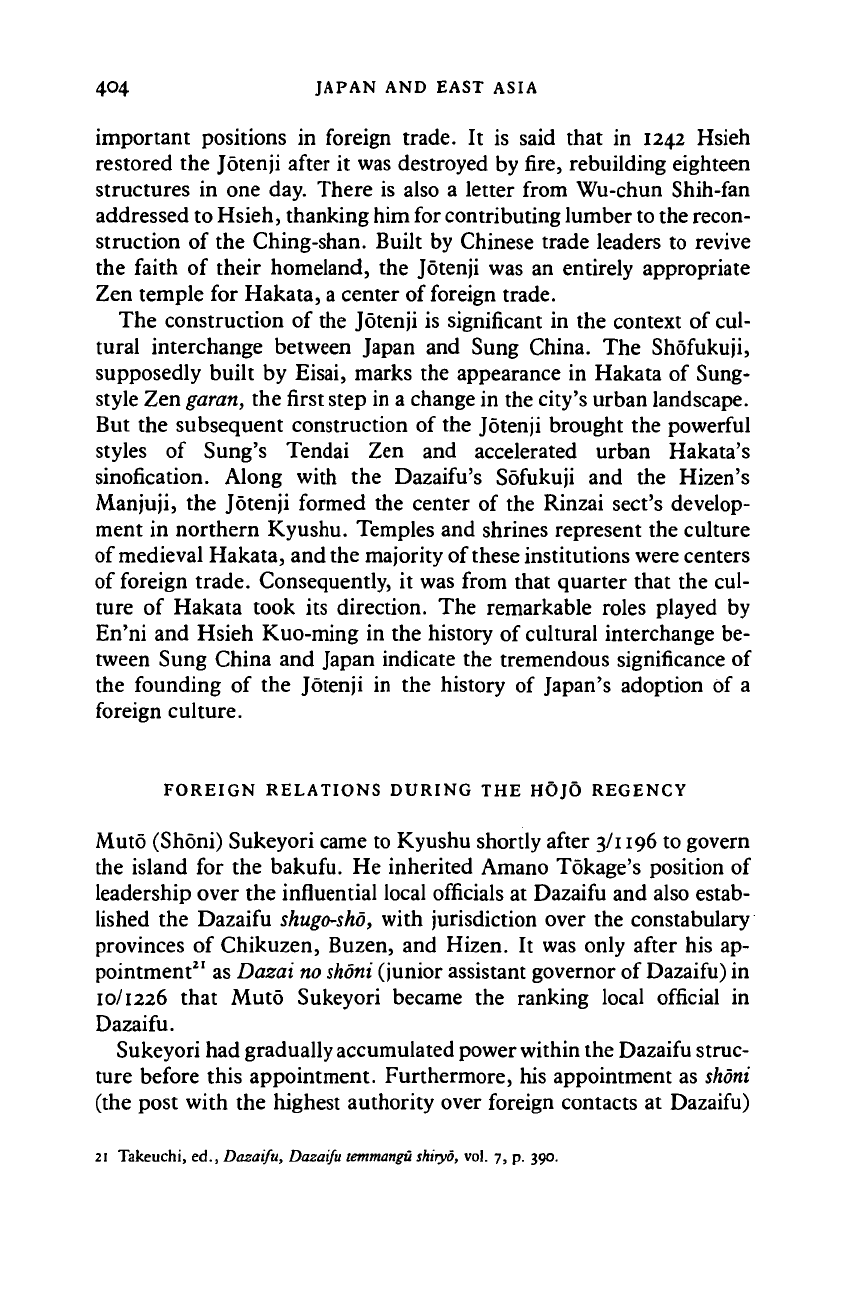
4O4 JAPAN AND EAST ASIA
important positions in foreign trade. It is said that in 1242 Hsieh
restored the Jotenji after it was destroyed by fire, rebuilding eighteen
structures in one day. There is also a letter from Wu-chun Shih-fan
addressed to Hsieh, thanking him for contributing lumber
to
the recon-
struction of the Ching-shan. Built by Chinese trade leaders to revive
the faith of their homeland, the Jotenji was an entirely appropriate
Zen temple for Hakata, a center of foreign trade.
The construction of the Jotenji is significant in the context of cul-
tural interchange between Japan and Sung China. The Shofukuji,
supposedly built by Eisai, marks the appearance in Hakata of Sung-
style Zen
garan,
the first step in a change in the city's urban landscape.
But the subsequent construction of the Jotenji brought the powerful
styles of Sung's Tendai Zen and accelerated urban Hakata's
sinofication. Along with the Dazaifu's Sofukuji and the Hizen's
Manjuji, the Jotenji formed the center of the Rinzai sect's develop-
ment in northern Kyushu. Temples and shrines represent the culture
of medieval Hakata, and the majority of these institutions were centers
of foreign trade. Consequently, it was from that quarter that the cul-
ture of Hakata took its direction. The remarkable roles played by
En'ni and Hsieh Kuo-ming in the history of cultural interchange be-
tween Sung China and Japan indicate the tremendous significance of
the founding of the Jotenji in the history of Japan's adoption of a
foreign culture.
FOREIGN RELATIONS DURING THE HOJO REGENCY
Muto (Shoni) Sukeyori came to Kyushu shortly after 3/1196 to govern
the island for the bakufu. He inherited Amano Tokage's position of
leadership over the influential local officials at Dazaifu and also estab-
lished the Dazaifu
shugo-sho,
with jurisdiction over the constabulary
provinces of Chikuzen, Buzen, and Hizen. It was only after his ap-
pointment
21
as Dazai
no shoni
(junior assistant governor of Dazaifu) in
10/1226 that Muto Sukeyori became the ranking local official in
Dazaifu.
Sukeyori had gradually accumulated power within the Dazaifu struc-
ture before this appointment. Furthermore, his appointment as
shoni
(the post with the highest authority over foreign contacts at Dazaifu)
21 Takeuchi, ed., Dazaifu, Dazaifu
temmangu
shiryo,
vol. 7, p. 390.
Cambridge Histories Online © Cambridge University Press, 2008
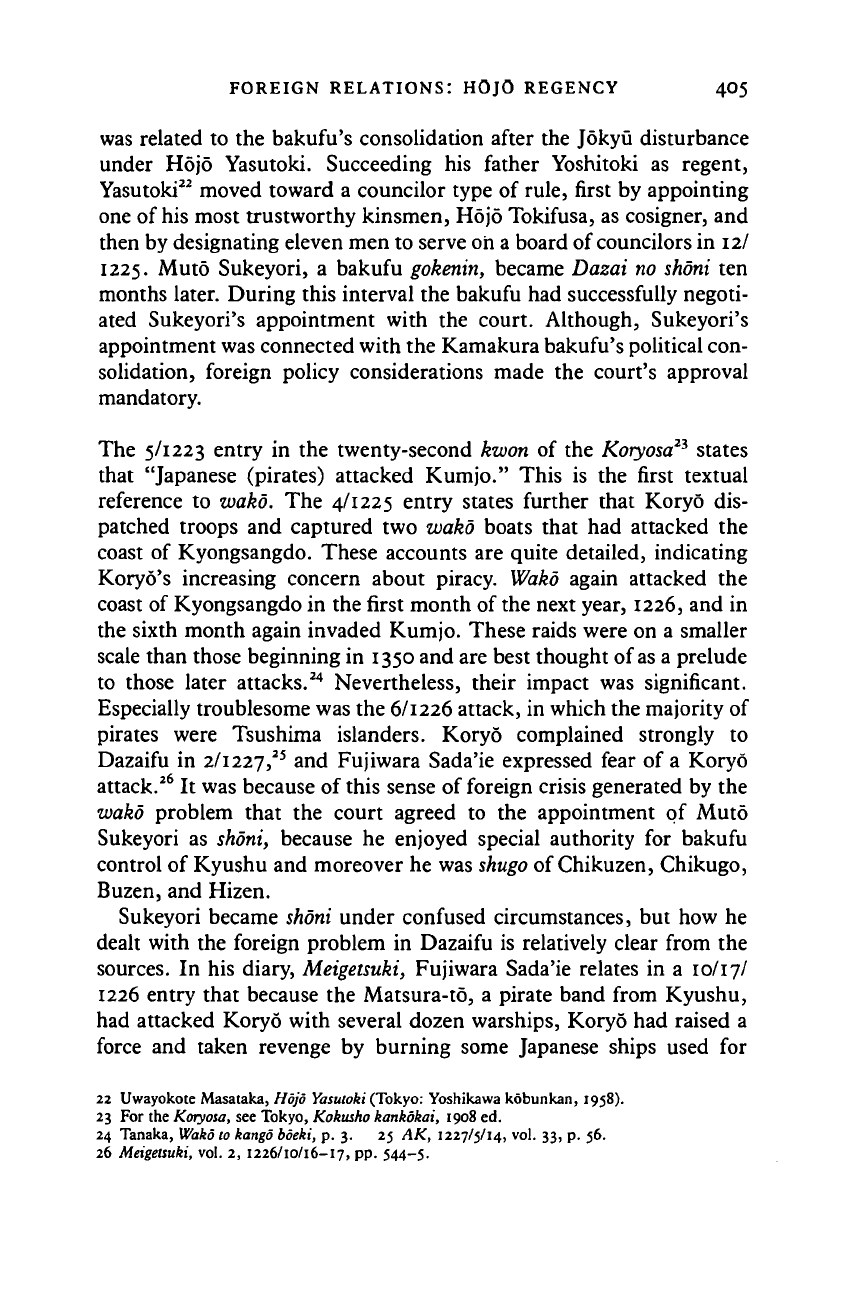
FOREIGN RELATIONS: HOjO REGENCY 405
was related to the bakufu's consolidation after the Jokyu disturbance
under Hojo Yasutoki. Succeeding his father Yoshitoki as regent,
Yasutoki" moved toward a councilor type of rule, first by appointing
one of his most trustworthy kinsmen, Hojo Tokifusa, as cosigner, and
then by designating eleven men to serve on a board of councilors in 12/
1225.
Muto Sukeyori, a bakufu gokenin, became Dazai no shoni ten
months later. During this interval the bakufu had successfully negoti-
ated Sukeyori's appointment with the court. Although, Sukeyori's
appointment was connected with the Kamakura bakufu's political con-
solidation, foreign policy considerations made the court's approval
mandatory.
The 5/1223 entry in the twenty-second kwon of the Koryosa
23
states
that "Japanese (pirates) attacked Kumjo." This is the first textual
reference to wako. The 4/1225 entry states further that Koryo dis-
patched troops and captured two wako boats that had attacked the
coast of Kyongsangdo. These accounts are quite detailed, indicating
Koryo's increasing concern about piracy. Wako again attacked the
coast of Kyongsangdo in the first month of the next year, 1226, and in
the sixth month again invaded Kumjo. These raids were on a smaller
scale than those beginning in 1350 and are best thought of
as
a prelude
to those later attacks.
24
Nevertheless, their impact was significant.
Especially troublesome was the 6/1226 attack, in which the majority of
pirates were Tsushima islanders. Koryo complained strongly to
Dazaifu in 2/1227,
25
and Fujiwara Sada'ie expressed fear of a Koryo
attack.
26
It was because of this sense of foreign crisis generated by the
wako problem that the court agreed to the appointment of Muto
Sukeyori as shoni, because he enjoyed special authority for bakufu
control of Kyushu and moreover he was
shugo
of Chikuzen, Chikugo,
Buzen, and Hizen.
Sukeyori became shoni under confused circumstances, but how he
dealt with the foreign problem in Dazaifu is relatively clear from the
sources. In his diary, Meigetsuki, Fujiwara Sada'ie relates in a 10/17/
1226 entry that because the Matsura-to, a pirate band from Kyushu,
had attacked Koryo with several dozen warships, Koryo had raised a
force and taken revenge by burning some Japanese ships used for
22 Uwayokote Masataka, Hojo Yasutoki (Tokyo: Yoshikawa kobunkan, 1958).
23 For the Koryota, see Tokyo, Kokusho kankokai, 1908 ed.
24 Tanaka, Wako to kango boeki, p. 3. 25 AK, 1227/5/14, vol. 33, p. 56.
26 Meigetsuki, vol. 2, 1226/10/16-17, pp. 544-5.
Cambridge Histories Online © Cambridge University Press, 2008
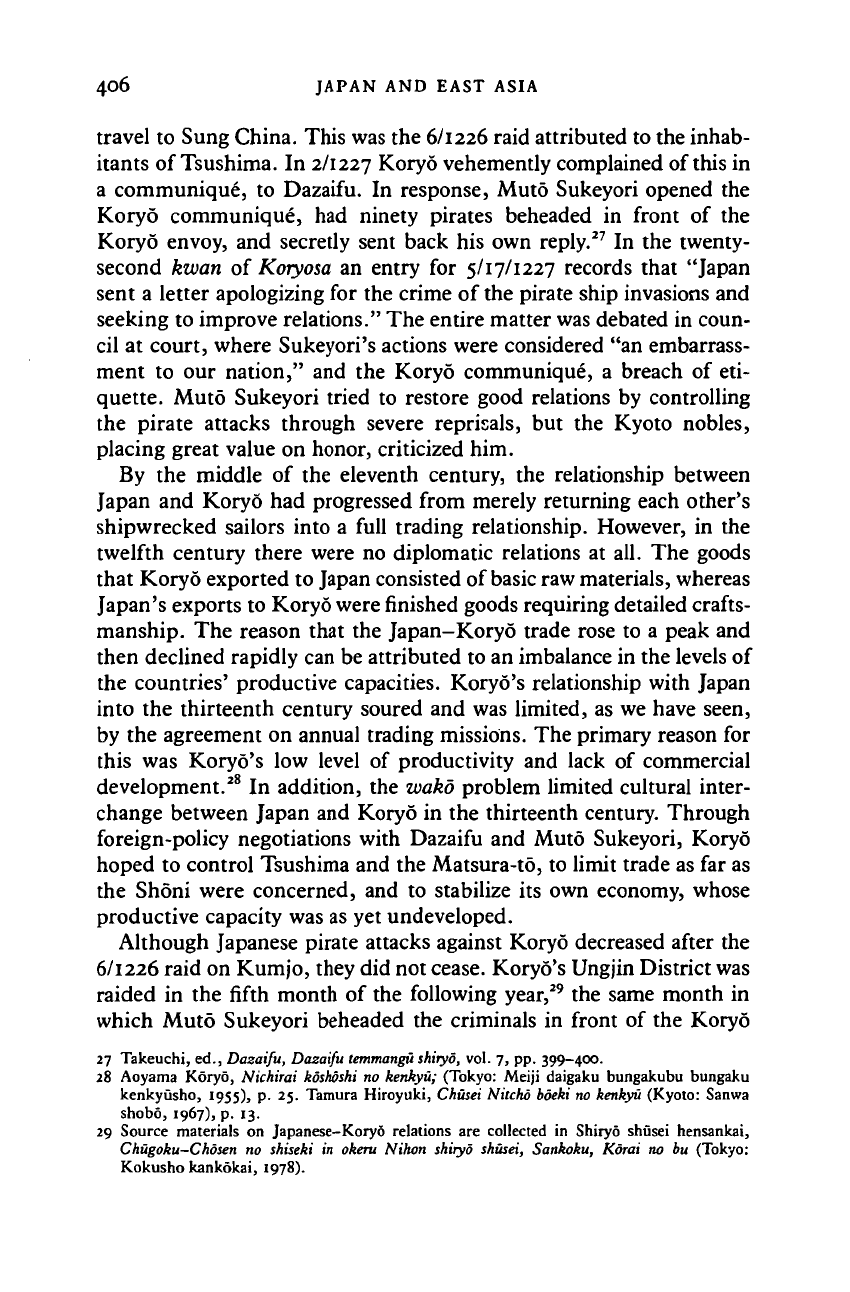
406 JAPAN AND EAST ASIA
travel
to
Sung China. This was the 6/1226 raid attributed to the inhab-
itants of Tsushima.
In
2/1227 Koryo vehemently complained of
this
in
a communique,
to
Dazaifu.
In
response, Muto Sukeyori opened
the
Koryo communique,
had
ninety pirates beheaded
in
front
of the
Koryo envoy,
and
secretly sent back
his
own reply.
27
In the
twenty-
second kwan
of
Koryosa
an
entry
for
5/17/1227 records that "Japan
sent
a
letter apologizing
for
the crime
of
the pirate ship invasions and
seeking to improve relations." The entire matter was debated in coun-
cil
at
court, where Sukeyori's actions were considered "an embarrass-
ment
to our
nation,"
and the
Koryo communique,
a
breach
of eti-
quette. Muto Sukeyori tried
to
restore good relations
by
controlling
the pirate attacks through severe reprisals,
but the
Kyoto nobles,
placing great value
on
honor, criticized him.
By
the
middle
of the
eleventh century,
the
relationship between
Japan
and
Koryo
had
progressed from merely returning each other's
shipwrecked sailors into
a
full trading relationship. However,
in the
twelfth century there were
no
diplomatic relations
at
all.
The
goods
that Koryo exported to Japan consisted of basic raw materials, whereas
Japan's exports
to
Koryo were
finished
goods requiring detailed crafts-
manship.
The
reason that the Japan-Koryo trade rose
to a
peak
and
then declined rapidly can be attributed to an imbalance in the levels of
the countries' productive capacities. Koryo's relationship with Japan
into
the
thirteenth century soured
and
was limited,
as
we have seen,
by
the
agreement
on
annual trading missions. The primary reason
for
this
was
Koryo's
low
level
of
productivity
and
lack
of
commercial
development.
28
In
addition,
the
wako problem limited cultural inter-
change between Japan
and
Koryo
in the
thirteenth century. Through
foreign-policy negotiations with Dazaifu
and
Muto Sukeyori, Koryo
hoped
to
control Tsushima and the Matsura-to,
to
limit trade as
far as
the Shoni were concerned,
and to
stabilize
its own
economy, whose
productive capacity was as yet undeveloped.
Although Japanese pirate attacks against Koryo decreased after
the
6/1226 raid on Kumjo, they did not
cease.
Koryo's Ungjin District was
raided
in the
fifth month
of
the following year,
29
the
same month
in
which Muto Sukeyori beheaded
the
criminals
in
front
of
the Koryo
27 Takeuchi,
ed.,
Dazaifu, Dazaifu lemmangu shiryo, vol.
7, pp.
399-400.
28 Aoyama Koryo, Nichirai koshoshi
no
kenkyu; (Tokyo: Meiji daigaku bungakubu bungaku
kenkyusho, 1955),
p. 25.
Tamura Hiroyuki, Chusei Nitcho boeki
no
kenkyu (Kyoto: Sanwa
shobo, 1967),
p. 13.
29 Source materials
on
Japanese-Koryo relations
are
collected
in
Shiryo shusei hensankai,
Chugoku-Chosen
no
skiseki
in
okeru Nihon shiryo shusei, Sankoku, Korai
no bu
(Tokyo:
Kokusho kankokai, 1978).
Cambridge Histories Online © Cambridge University Press, 2008
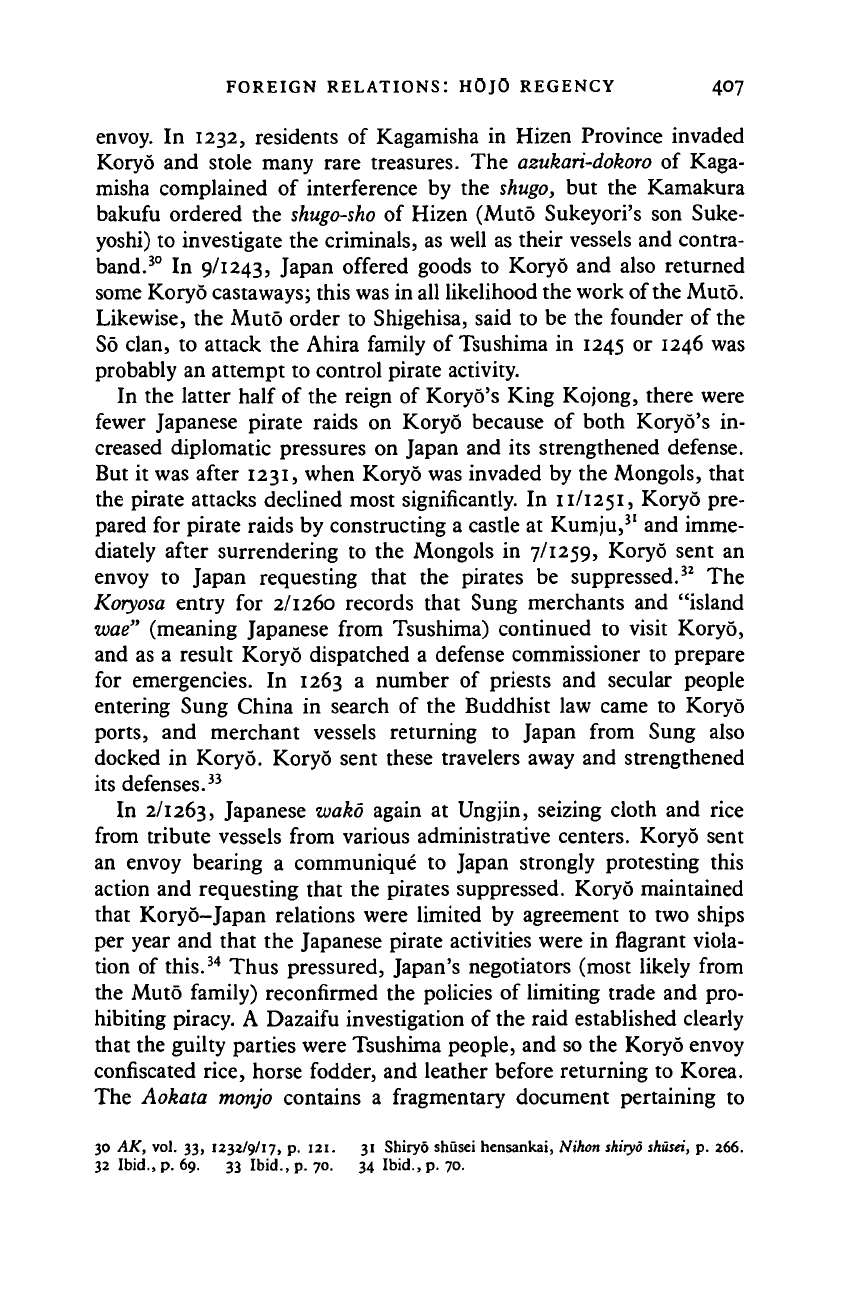
FOREIGN RELATIONS: HOJO REGENCY 407
envoy. In 1232, residents of Kagamisha in Hizen Province invaded
Koryo and stole many rare treasures. The azukari-dokoro of Kaga-
misha complained of interference by the shugo, but the Kamakura
bakufu ordered the shugo-sho of Hizen (Muto Sukeyori's son Suke-
yoshi) to investigate the criminals, as well as their vessels and contra-
band.
30
In 9/1243, Japan offered goods to Koryo and also returned
some Koryo castaways; this was in all likelihood the work of the Muto.
Likewise, the Muto order to Shigehisa, said to be the founder of the
So clan, to attack the Ahira family of Tsushima in 1245 or 1246 was
probably an attempt to control pirate activity.
In the latter half of the reign of Koryo's King Kojong, there were
fewer Japanese pirate raids on Koryo because of both Koryo's in-
creased diplomatic pressures on Japan and its strengthened defense.
But it was after 1231, when Koryo was invaded by the Mongols, that
the pirate attacks declined most significantly. In
11/1251,
Koryo pre-
pared for pirate raids by constructing a castle at Kumju,
31
and imme-
diately after surrendering to the Mongols in 7/1259, Koryo sent an
envoy to Japan requesting that the pirates be suppressed.
32
The
Koryosa entry for 2/1260 records that Sung merchants and "island
wae" (meaning Japanese from Tsushima) continued to visit Koryo,
and as a result Koryo dispatched a defense commissioner to prepare
for emergencies. In 1263 a number of priests and secular people
entering Sung China in search of the Buddhist law came to Koryo
ports,
and merchant vessels returning to Japan from Sung also
docked in Koryo. Koryo sent these travelers away and strengthened
its defenses.
33
In 2/1263, Japanese wako again at Ungjin, seizing cloth and rice
from tribute vessels from various administrative centers. Koryo sent
an envoy bearing a communique to Japan strongly protesting this
action and requesting that the pirates suppressed. Koryo maintained
that Koryo-Japan relations were limited by agreement to two ships
per year and that the Japanese pirate activities were in flagrant viola-
tion of this.
34
Thus pressured, Japan's negotiators (most likely from
the Muto family) reconfirmed the policies of limiting trade and pro-
hibiting piracy. A Dazaifu investigation of the raid established clearly
that the guilty parties were Tsushima people, and so the Koryo envoy
confiscated rice, horse fodder, and leather before returning to Korea.
The Aokata monjo contains a fragmentary document pertaining to
30 AK, vol. 33, 1232/9/17, p. 121. 31 Shiryo shusei hensankai, Nihon
shiryo
shusei,
p. 266.
32 Ibid., p. 69. 33 Ibid., p. 70. 34 Ibid., p. 70.
Cambridge Histories Online © Cambridge University Press, 2008
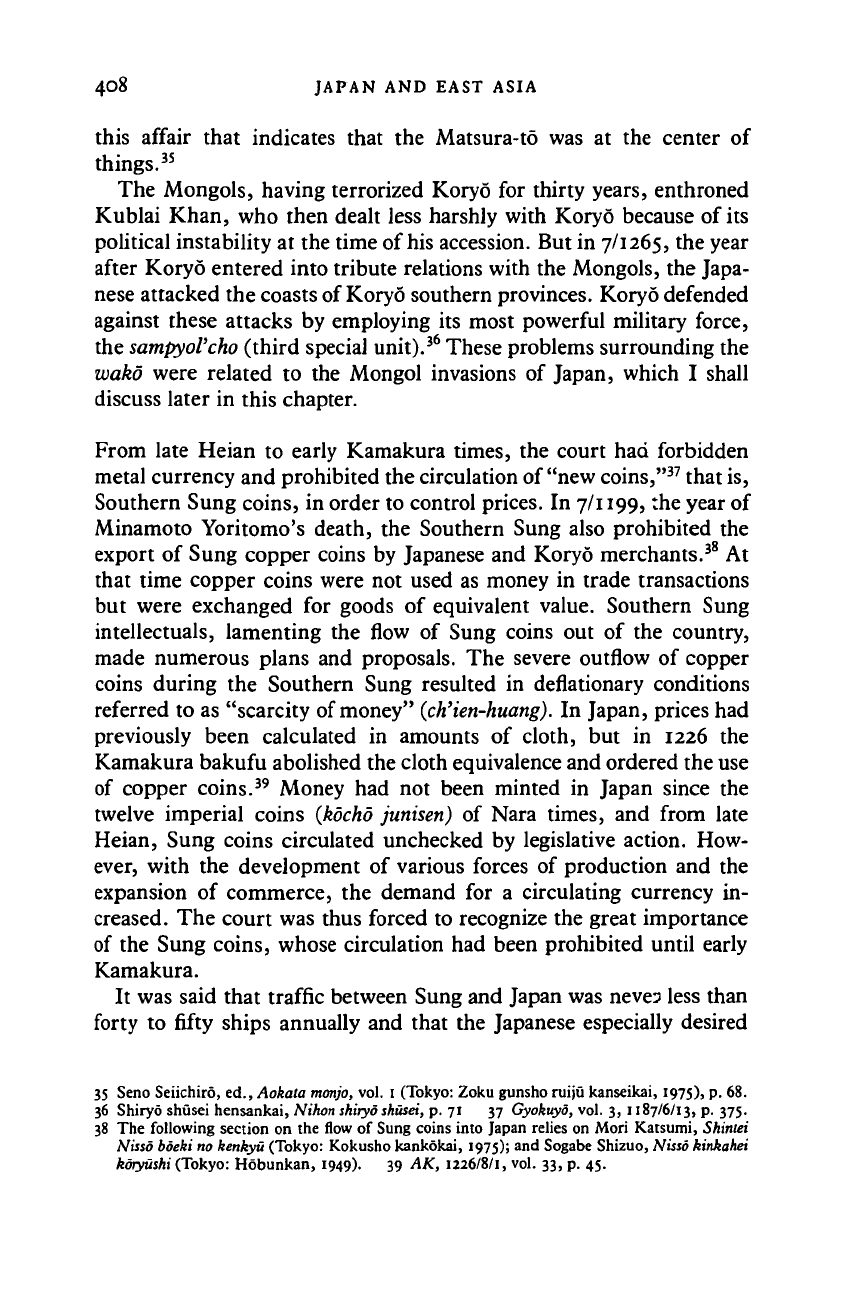
408 JAPAN AND EAST ASIA
this affair that indicates that the Matsura-to was at the center of
things.
35
The Mongols, having terrorized Koryo for thirty years, enthroned
Kublai Khan, who then dealt less harshly with Koryo because of its
political instability at the time of
his
accession. But in 7/1265, the year
after Koryo entered into tribute relations with the Mongols, the Japa-
nese attacked the coasts of Koryo southern provinces. Koryo defended
against these attacks by employing its most powerful military force,
the
sampyol'cho
(third special unit).
36
These problems surrounding the
wako were related to the Mongol invasions of Japan, which I shall
discuss later in this chapter.
From late Heian to early Kamakura times, the court had forbidden
metal currency and prohibited the circulation of "new coins,"
37
that is,
Southern Sung coins, in order to control prices. In 7/1199, the year of
Minamoto Yoritomo's death, the Southern Sung also prohibited the
export of Sung copper coins by Japanese and Koryo merchants.
38
At
that time copper coins were not used as money in trade transactions
but were exchanged for goods of equivalent value. Southern Sung
intellectuals, lamenting the flow of Sung coins out of the country,
made numerous plans and proposals. The severe outflow of copper
coins during the Southern Sung resulted in deflationary conditions
referred to as "scarcity of
money"
(ch'ien-huang).
In Japan, prices had
previously been calculated in amounts of cloth, but in 1226 the
Kamakura bakufu abolished the cloth equivalence and ordered the use
of copper coins.
39
Money had not been minted in Japan since the
twelve imperial coins
(kocho junisen)
of Nara times, and from late
Heian, Sung coins circulated unchecked by legislative action. How-
ever, with the development of various forces of production and the
expansion of commerce, the demand for a circulating currency in-
creased. The court was thus forced to recognize the great importance
of the Sung coins, whose circulation had been prohibited until early
Kamakura.
It was said that traffic between Sung and Japan was nevep less than
forty to fifty ships annually and that the Japanese especially desired
35
Seno
Seiichiro,
ed., Aokata
monjo,
vol. I
(Tokyo:
Zoku gunsho ruiju kanseikai,
1975),
p. 68.
36
Shiryo shusei hensankai, Nihon shiiyd
shusei,
p. 71 37
Gyokuyo,
vol. 3,
1187/6/13,
p. 375.
38
The following section on the flow of Sung coins into Japan relies on Mori Katsumi, Shintei
Nisso
boeki no kenkyu
(Tokyo:
Kokusho kankokai,
1975);
and Sogabe
Shizuo,
Nissd
kinkahei
kdryushi
(Tokyo:
Hobunkan,
1949).
39 AK,
1226/8/1,
vol. 33, p. 45.
Cambridge Histories Online © Cambridge University Press, 2008
